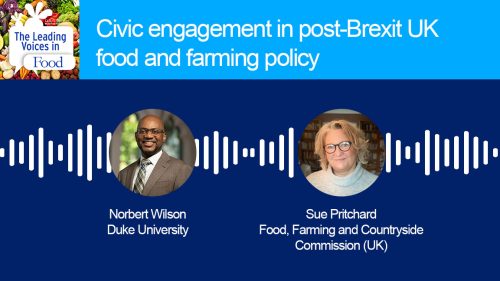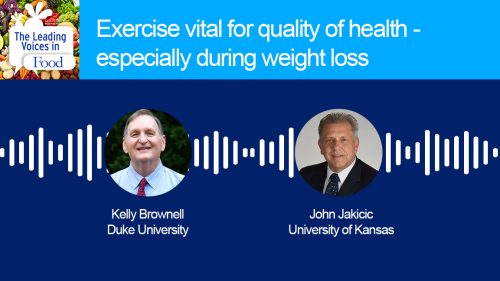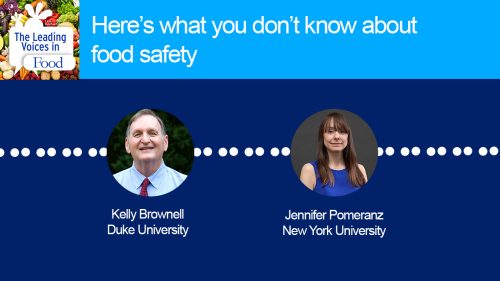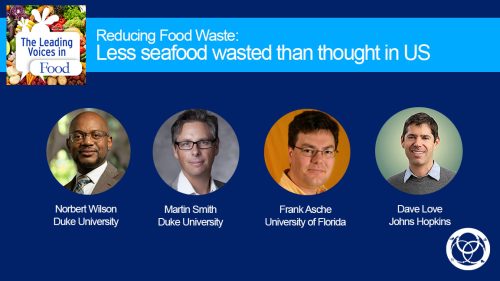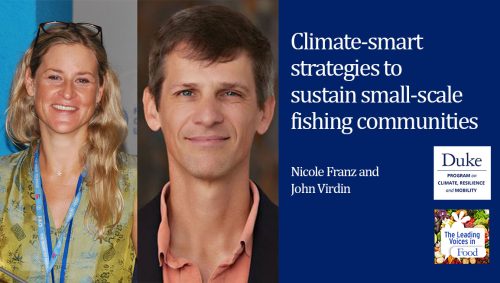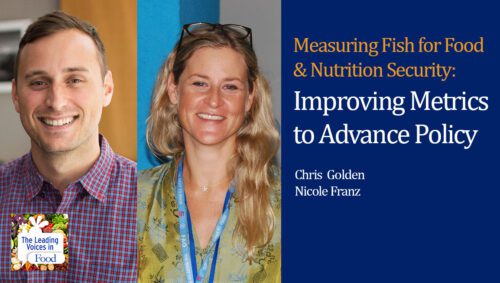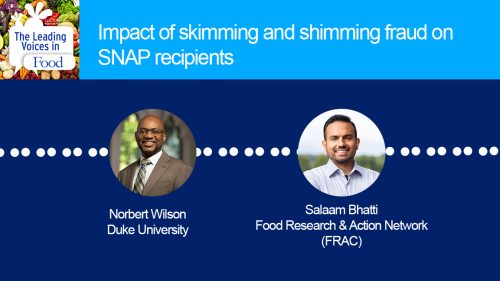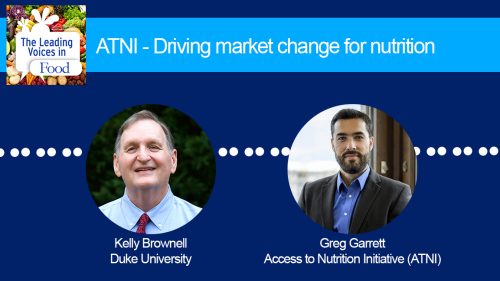The Leading Voices in Food
E131: Fisheries Need Stronger Role in Food Policy and Food Security Planning
Fish is food, right? Well, it hasn’t always been treated that way in policy dialogues and development funding, according to a recent paper in AMBIO. Fisheries management practices and policies most often treat fish as a natural resource or a trade commodity, rather than an important contributor to food security. At the same time, food security policy and funding have focused primarily on agriculture instead of fish. This podcast is part of a series on fisheries and nutrition and a movement to bring fisheries into international food policy and programming.
Subscribe: Apple Podcasts | TuneIN | YouTube Music | SoundCloud | PocketCasts | Radio Public
Tags: Climate Change, Environment & Food | Diet & Nutrition | Fisheries & Food Policy | Food Policy |

Elin Torell is the Director of International Coastal Programs, Evaluation, Livelihoods and Gender at the University of Rhode Island Coastal Resources Center. She provides programmatic direction and selected technical support within her main areas of expertise: monitoring, evaluation and learning, livelihood development, gender mainstreaming, population and environment, civil society, fisheries management and environmental compliance. Elin has more than 15 years of experience providing technical assistance and leading complex and interdisciplinary projects in East Africa and South East Asia. She is an expert in project management and developing and leading strategic planning, monitoring and evaluation systems that foster learning within projects as well as across multiple projects. Elin has a Ph.D. in environmental studies, an MsC. in human and economic geography and a bachelor’s degree in social science.
Belinda Richardson is a Fellow at the Bill and Melinda Gates Foundation, having also worked as a technical consultant for the World Food Program and as a teaching assistant at UC Davis, where she completed a Master’s Degree in Agricultural Economics and International Development.
Interview Summary
Welcome to “The Leading Voices in Food” podcast. I’m Sarah Zoubek, associate director of the World Food Policy Center at Duke University. My co-host today is World Food Policy Center alum and Michigan State University Fishery Social Scientist, Abigail Bennett.
So today we’re also joined by two guests. Belinda Richardson, agricultural development expert from the Gates Foundation and International Coastal Programs expert, Elin Torell of the University of Rhode Island. We’ve asked Belinda and Elin to push and pull on ideas from our recent paper on fisheries policy published in the journal, AMBIO.
So Abby, can you help us lay the scene here before Elin and Belinda jump in? How could fish not be treated as food?
So in our paper, we describe how fish and food security policy are disconnected from one another. Let me give a couple of examples for our listeners. The UN sustainable development goal number two on zero hunger doesn’t mention fisheries or aquaculture by name or outline specific guidance for them. The global nutrition report that tracks global nutrition commitments every year only mentioned fisheries for the first time in 2017. And the World Bank, a big player in agricultural development funding, has allocated only around two and a half percent of its agricultural portfolio to fisheries and aquaculture over the past decade, although this has ticked up to above 5% in 2018. So Belinda and Elin, why do you think fish has been so disconnected from the food policy arena and do you see this changing?
Elin: I would say that a major reason why fish has been a bit disconnected is because it’s a common property resource. Fish doesn’t have boundaries, it moves around. It’s not as easy to manage as agriculture for sure. And there’s so many different fish in the oceans, everything from our precious coral reef fish to small pelagics and large pelagics and so forth. So it’s very, very complicated. I would say that for aquaculture, it’s been really contentious both from an environmental perspective and I would say also from an equity perspective. Belinda, I’d love to hear your thoughts.
Belinda: The Gates Foundation is a relatively new donor coming into this sub sector of agriculture. The agricultural development team at the Gates Foundation began looking carefully at fish and aquaculture for its potential to impact poverty and nutrition only very recently in 2017. And we were surprised, frankly, at the size and the dynamism of the sector. So it’s the fastest growing food sector, 10% annual growth per year. Demand for fish is growing fastest in South Asia and Sub-Saharan Africa and it’s very important nutritionally. An estimated 3.3 billion people get at least 20% of their protein from fish. And as the nutrition community starts shifting from counting calories to tracking dietary diversity and the nutrient density of foods, fish becomes a very important source of essential macro and micro nutrients. And I think part of the challenge as a data-driven organization was really the lack of data and the complexities around data quality and availability affecting low middle income countries are not necessarily specific to the fishery sector. The data are particularly sparse for small scale fisheries and aquaculture. And so I think as more data become available through public and private investment from different innovations, we can see a bit more clearly how many people depend on fish for food, for livelihoods and nutrition and the sectors’ impact on food security. And if I can just make one last point here, I think importantly as climate and the environment keep climbing on the global agenda, as Elin said, aquaculture’s been very contentious. I think aquaculture and fisheries have their sustainability issues but fish is the most efficient animal protein, so it can really help to alleviate some of the pressure on land agriculture. So as we start to grapple with how to produce enough food within planetary boundaries, fish is going to be a necessary part of that story.
Thanks, Belinda. And you’ve mentioned funding development projects around fisheries and I’d like to drill down on that a bit further. So have the both of you seen the funding landscape for fisheries and aquaculture, or the narratives and dialogues around fisheries and aquaculture in the funding landscape change in the last 10 years?
Elin: The University of Rhode Island has been implementing international fisheries programs in developing countries since about the mid-1980s. And I would say that until about 10 years ago, our fisheries work was really under the umbrella of marine conservation to protect coral reefs and other important habitats and charismatic species and global marine biodiversity. But over the last 10 years, there has been an increased recognition of the importance of fish for food security in many countries but especially in West Africa and Asian countries like Bangladesh, the Philippines, Vietnam and this has opened up some possibilities for us to work on fisheries from a food security perspective. And to some extent, we are dealing with a different type of species under the food security umbrella. We’re looking at small pelagics and other fish that are incredibly important for food security in many countries. And we’ve seen the US government and USAID fund multiple projects. I’m also involved as the deputy director in the Feed the Future fish innovation lab and there we do fisheries for food security programming in many countries around the world. I think another really cool shift is increased recognition of women’s role, both as harvesters of fish and their roles in value chains and the importance of empowering women to participate both in fisheries management and in the production. We do know from our research and implementation of fisheries work that women are critical in the harvesting of fish and in feeding their families. So you really need to have women involved. Those are a couple of the shifts that I’ve seen. Now, I’d love to turn it over to Belinda.
Belinda: I can really only speak to the last three or four years since we’ve been exploring aquaculture at the foundation but we were actually really surprised to see the increasing interest in investment into the sector from both the public and the private sector. So it’s increasing on countries’ agendas, planning and prioritization. That means countries are either allocating money from their national budgets or they’re taking out loans against those priorities to develop the sector. As Elin said, looking at not just food security but also economic growth and then adjusting policies to incentivize investment by the private sector. Investment by private sector itself has really been another signal. Industry’s responding to the strong demand pool from consumers. So as populations and incomes are rising pretty much across the board, now with some setbacks due to the pandemic but hopefully that trend will get back on track. The demand for fish is also rising and while most of the innovation for high value species like shrimp and salmon has come from the private sector, these companies are really starting to recognize the importance and the opportunity in low and middle income countries and that includes large and small producers who rely on lower value species like tilapia, carp and catfish which we could consider more staple commodities versus like salmon or tuna, which are kind of the champagne of fish. And these lower value species and production systems could really benefit from the innovations that private sector brings in genetics, feed, aquatic animal health. That could boost productivity and profitability and supply more fish.
Thanks, Belinda and Elin. It’s really interesting to have both of your insider perspectives on how some of that funding landscape has been changing recently. Are there challenges in development projects that are unique to fisheries and aquaculture, especially as compared to agriculture?
Elin: The fact that fish is a common property resource is definitely an issue because when you think about the geographies and your stakeholders, you know some of the sardinella, for example, in West Africa may swim across five or six countries. So how do you get all the right stakeholders and all the right people to the table? Not only decision makers but private industry and fishers and gear owners, boat owners have to come to the table. So that makes it very complicated. The second issue is the tension between conservation and productivity. We know that we need to have a sustainable fisheries in order to feed future generations. But in order to reach that sustainability, we may need to make some sacrifices in the short term through closed seasons or quotas or total allowable catches or whatever it is. And we could call that a delay in production and during those stoppages, people that are really dependent on fisheries for their livelihoods and for food security may be suffering. So that’s a challenge I think we need to look at. How do we address that? What is our arsenal of solutions, whether it’s through conditional cash transfers, through importation, private sector engagement? Those are some challenges that we need to address. Now, I’d love to turn it over to Belinda.
Belinda: So from the donor perspective, increasing investment into the agricultural sectors, you always run the danger of unintended consequences but because we’ve hit or are approaching the carrying capacity limits of our oceans and freshwater bodies, which basically means that over 60% of the world’s fish stocks are now over-exploited beyond their biological sustainability limits, there’s an instinct to say that we can fill that supply and demand gap with fish from aquaculture which at first glance is true and mathematically, the calculation works out but there are two challenges I want to flag. The one is nutrition and the other one is environment. There are a lot of challenges when we talk about sustainable intensification related to fisheries in aquaculture. You’ve got effluent hormones, antibiotic use, farmed and wild fish disease interface. But one in particular is the specific environmental trade-off around the fishmeal debate. So, fish for feed versus fish for food. 22% of fish landed in captured fisheries according to FAO is destined for fishmeal. The vast majority of that is human grade food. So if we’re looking at the whole system, can we do a better job balancing this equation of where fish is coming from? And also, what are the more nutritious species? So from a nutrition lens, if we look at this problem, smaller marine or indigenous species that people might eat whole, for example, they’ve got calcium in the bones, vitamin A in the eyes, these are much more nutrition-dense than like a filet that you would eat from a salmon, for example. So just thinking a little bit more holistically about the nutrient content of these fish where they’re coming from and the environmental limit.
Elin: I 100% agree with your comments about this debate between pitch food versus people food and where does the fish go? And I think that’s why there’s a lot of research going into alternate feed for aquaculture as well. And there’s also multiple efforts to think about how we can use some of that fish that would go into fish feed and turn it into products that may be used for pregnant women and children in the first thousand days of life.
So I think it’s always good to follow up a discussion on challenges with some successes. So I’m curious, what are some of the measurable impacts of the recent funding efforts that can already be seen or that we might be able to soon see from these investments in fisheries and aquaculture sectors?
Elin: I’m really, really proud of the work that we’ve been doing in empowering women cleaners. This is something we’ve been working on throughout the world in West Africa, East Africa and Southeast Asia. Some recent successes has been in West Africa, in the Gambia and in Ghana, where we worked with women who were harvesting oysters to both work with them to protect their oyster resources through establishing no-take areas or closed seasons and we’ve seen some improved stocks. We are seeing that the oysters are coming back and the women we are working with are really encouraged and they’re continuing to renew their closed season on their own. We do see that economic empowerment is incredibly important. Some of our research in Malawi found that women who were generating an income from the fisheries sector have a higher negotiating power within their households. And they’re more able to participate in fisheries management. And this is something we’ve seen also again in the Philippines and in West Africa. And our work in West Africa is starting to evolve now, moving from The Gambia and Ghana to other countries in the region. Our work with the small pelagics and a broader ecosystem approach to fisheries management is a lot more complicated. And while we’re very hopeful that we’re going to see good improvements in fish biomass over time, for now, I feel like our biggest wins have been at the enabling conditions and policy governance sites. For example, our work in Ghana. The government of Ghana has adopted a national fisheries co-management policy. And at the more local level we have community-based fishery school management plans that we feel comfortable that we’ve contributing to really set a base for seeing great measurable impacts, even though we haven’t seen them yet.
So Belinda, I’m curious for you – what are some of the measurable impacts of recent funding efforts you feel like we can already see or that we might soon see in fisheries and aquaculture?
Belinda: So from the Gates Foundation perspective. There are some great technologies and innovations in aquaculture, specifically. We’ve seen technologies and innovations in aquaculture generate real results for productivity and profitability, even for very small scale producers in field trials. Looking at those technologies, that’s really something that we’d like to build on. Take these innovations to scale, create sustainable market linkages for small scale producers, so hopefully increase livelihoods and nutrition. So just an example, with breeding and through new genomic tools, genetic gains result in fish with faster growth rates, more feed efficiency, more disease resistance which will be important with climate change as you get intensification. If you think about the large amount of small scale producers in low and middle-income countries and their low yields currently and then you multiply that by the productivity increases from these technologies, that’s a huge potential. So hopefully, if countries can do this well, that translates into income for small scale farmers and better nutrition for a range of consumers. Along that impact pathway, The Gates Foundation is looking to these technologies and innovations to pick those up and disseminate those to small scale producers.
Thanks, Elin and Belinda. It’s really exciting and encouraging to hear about those pieces of progress, ranging from technological developments, all the way to setting the policy and governance stage for these things to have impact on livelihoods and food security. So I want to end on a question that’s a bit forward-looking and ask what are you most excited about that is on the horizon for fisheries and aquaculture?
Elin: I am really excited about working more on fisheries in ways that strengthens the role of women and youth in marginalized groups. I feel like we’ve made some headway on gender and I would love to bring some of those experiences into also including youth and marginalized groups and really try to find win-win initiatives where we can promote synergies between food security including nutrition, of course, and conservation outcomes.
Belinda, I’d love to hear your thoughts on this as well.
Belinda: Adaptation to climate change is quickly becoming a top priority for fishing communities and fish farmers. The people who depend on fisheries and aquaculture for livelihoods and nutrition and the majority of which are in these low and middle income countries and often the most vulnerable to climate change. This underlying vulnerability makes them particularly susceptible to the stressors and impacts from climate change. So if we think about this challenge also as an opportunity so everything that Elin mentioned around gender, some of these initiatives where you can have a win-win for nutrition and food security and also conservation and environmental sustainability, this seems like a really opportune time for fish to be getting more of a spotlight.



